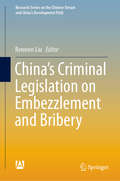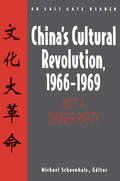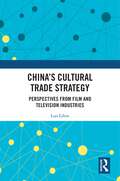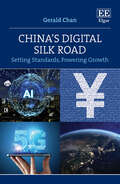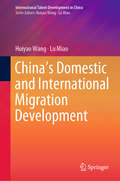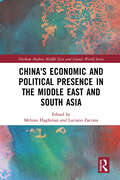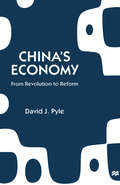- Table View
- List View
China's Crafts: The Story of How They're Made and What They Mean (Routledge Library Editions: Chinese Literature and Arts #3)
by Roberta Helmer Stalberg Ruth NesiThis book, first published in 1981, provides a comprehensive appraisal of China’s crafts. Its historical approach and numerous illustrations not only reveal the ancient origins of many of China’s arts, but also offer the means for evaluating modern crafts in light of past achievements.
China's Crafts: The Story of How They're Made and What They Mean (Routledge Library Editions: Chinese Literature and Arts #3)
by Roberta Helmer Stalberg Ruth NesiThis book, first published in 1981, provides a comprehensive appraisal of China’s crafts. Its historical approach and numerous illustrations not only reveal the ancient origins of many of China’s arts, but also offer the means for evaluating modern crafts in light of past achievements.
China’s Criminal Legislation on Embezzlement and Bribery (Research Series on the Chinese Dream and China’s Development Path)
by Renwen LiuThis book discusses in a Chinese context the criminal policy and legislation related to embezzlement and bribery, which are considered major problems of global significance in both theory and practice, and in so doing to demonstrate the progress made by the Chinese government over the last 30 years with regard to preventing these crimes. More specifically, it addresses a variety of issues, such as embezzlement and bribery legislation and its history in New China; the effects of legislation on judicial practice; criminological analysis of the causes of corruption crimes; related criminal statutes and their improvements; judicial interpretation, sentencing issues and prevention measures; the design and improvement of related criminal procedure; comparative studies on laws in relation to the punishment and prevention of corruption crimes; and international cooperation in the pursuit of corrupt officials. In a word, taking the relevant history and current reality, as well as domestic and international prevention mechanisms into account, the book discusses the legal framework, evaluates its implementation, reviews the merits and shortcomings of criminal legislation and judicial practice, and puts forward legislative and judicial proposals regarding prevention mechanisms. It offers a comprehensive but accessible (academic) reference work for legal researchers, students, lawyers and all others interested in the criminal legislation and policy with regard to corruption crimes in China.
China's Cultural Revolution, 1966-69: Not a Dinner Party
by Michael SchoenhalsMao Zedong launched the "Great Proletarian Cultural Revolution" 30 years ago. This documentary history of the event presents a selection of key primary documents dealing with the Cultural Revolution's massive and bloody assault on China's political and social systems.
China's Cultural Revolution, 1966-69: Not a Dinner Party
by Michael SchoenhalsMao Zedong launched the "Great Proletarian Cultural Revolution" 30 years ago. This documentary history of the event presents a selection of key primary documents dealing with the Cultural Revolution's massive and bloody assault on China's political and social systems.
China's Cultural Trade Strategy: Perspectives from Film and Television Industries
by Luo LibinThis book aims to provide theoretical and empirical interpretations of certain phenomena in the development of China's cultural industry. Using the film and television industries as the major cases, the author proposes suggestions on China's ongoing development of foreign cultural trade. The author argues that China is well positioned to take full advantage of the opportunities of globalization, to develop its cultural industry in a leapfrog manner. China's rapid economic growth drives the country's development from a small cultural market to a large one. Since it is a middle-income country, its cultural industry still has a relatively large potential to grow. The study on China's foreign cultural trade strategy can contribute to the growing needs of people for a better life and enhance China's "cultural confidence". With an explanation of existing practices, this book also aims to make recommendations on China's strategy for developing foreign cultural trade in the era of globalization. This book will be a good read for students, researchers and scholars of Chinese studies, East Asian studies and culture economics, and those interested in China's film and television industries.
China's Cultural Trade Strategy: Perspectives from Film and Television Industries
by Luo LibinThis book aims to provide theoretical and empirical interpretations of certain phenomena in the development of China's cultural industry. Using the film and television industries as the major cases, the author proposes suggestions on China's ongoing development of foreign cultural trade. The author argues that China is well positioned to take full advantage of the opportunities of globalization, to develop its cultural industry in a leapfrog manner. China's rapid economic growth drives the country's development from a small cultural market to a large one. Since it is a middle-income country, its cultural industry still has a relatively large potential to grow. The study on China's foreign cultural trade strategy can contribute to the growing needs of people for a better life and enhance China's "cultural confidence". With an explanation of existing practices, this book also aims to make recommendations on China's strategy for developing foreign cultural trade in the era of globalization. This book will be a good read for students, researchers and scholars of Chinese studies, East Asian studies and culture economics, and those interested in China's film and television industries.
China’s Demographic Dilemma and Potential Solutions: Population Aging and Population Control (Research Series on the Chinese Dream and China’s Development Path)
by Long Mo Yuhong WeiThis book is a quantitative assessment of the challenges China faces as it tries to achieve the twin goals of mitigating the effects of population aging while containing the overall size of the population. After a close examination of the impact of China’s fertility policies on the country’s population structure and size, the author presents empirical evidence for the effectiveness of finely calibrated easing of the country’s decades-long birth control policies for both of these objectives. This research uses an innovative quantitative indicator—the Aging and Economic Coordination Index (AECI)—to measure the macroeconomic pressure population aging places on the country. This is the first time the AECI has been systematically applied to gauge the magnitude and the trends of that pressure for the 1980–2050 period, and to provide the basis for policy suggestions about what might be done to ease that pressure.
China’s Development Under a Differential Urbanization Model (Research Series on the Chinese Dream and China’s Development Path)
by Qiang LiThis book analyses the particular nature, characteristics and current conditions of urbanization in China. It reviews the theory of “urbanization with a diversified process” and puts forward the basic principles for promoting urbanization on the basis of a perspective reflecting the diversified sizes of towns and cities. Further, it assesses the overall strategic planning for advancing urbanization and explores the characteristics of an urban society formed on the basis of diversified urbanization.
China’s Digital Authoritarianism: A Governance Perspective (Politics and Development of Contemporary China)
by Monique TaylorThis book provides a governance perspective on China’s digital authoritarianism by examining the political and institutional dynamics of the country’s internet sector in a historical context. Using leading theories of authoritarian institutions, it discusses China’s approach to the internet and methods of implementation in terms of party-state institutions and policy processes. This provides a much-needed ‘inside out’ perspective on digital authoritarianism that avoids the perception of China as some coherent and static monolith. The study also offers a powerful rationale for China’s cyber sovereignty as an externalisation of its domestic internet governance framework and broader political-economic context. As China shifts from rule-taker to rule-maker in world politics, the Chinese Dream (zhongguo meng) is now going global. Beijing’s digital authoritarian toolkit is being promoted and exported to other authoritarian regimes, making China a major driver of digital repression at the global level.
China’s Digital Silk Road: Setting Standards, Powering Growth
by Gerald ChanIn recent years, China has become a world leader in e-commerce, e-currency, 5G and artificial intelligence, cementing itself as a major competitor to established powers. Gerald Chan poses the question: How has China pulled this off? Arguing that the answer lies in the country’s Digital Silk Road, a multi- faceted programme to connect the world via digital means, the book explores how China has shaped the development of the digital order, secured a critical role in internet governance and upset the status-quo powers.Integrating empirical research with innovative theory, this forward-looking book is the first of its kind to unravel the complex web spun through China’s Digital Silk Road. Chapters offer a unique Chinese perspective on the evolution of the global digital economy and digital currencies, highlighting China’s growing influence in driving technological development and setting global industrial standards. Following on from Chan’s previous publications on the country’s high-speed rail networks and maritime infrastructure, China’s Digital Silk Road offers a timely look at China’s predominant role in shaping the global digital order.Advancing a geo-developmental framework to analyse China’s Belt and Road Initiative, the book will be of unique interest to students and scholars of Chinese politics and global development.
China’s Domestic and International Migration Development (International Talent Development in China)
by Huiyao Wang Lu MiaoThis book offers the most comprehensive, up-to-date assessment of China’s domestic and international migration. Restructuring economic development requires large numbers of educated and skilled talents, but this effort comes at a time when the size of China’s domestic workforce is shrinking. In response, both national and regional governments in China have been keen to encourage overseas Chinese talents and professionals to return to the country. Meanwhile, the Chinese government has initiated a number of policies to attract international highly-skilled talents and enhance the country’s competitiveness, and some Chinese policies have started attracting foreign talents, who are coming to the country to work, and even to stay. Since Chinese policies, mechanisms, and administration efforts to attract and retain skilled domestic or overseas talents are helping to reshape China’s economy and are significantly affecting the cooperation on migration and talent mobility, these aspects, in addition to being of scholarly and research interest, hold considerable commercial potential.
China's Economic and Political Presence in the Middle East and South Asia (Durham Modern Middle East and Islamic World Series)
by Mehran Haghirian Luciano ZaccaraThis book explores a range of key issues connected to China’s relations with countries in the Middle East and South Asia. It discusses economic and political connections, and projects which have arisen as part of China’s Belt and Road Initiative. It covers both important countries in the Middle East, and also Pakistan, Bangladesh and Afghanistan. It examines current contentious issues including Iranian sanctions and the war in Syria, and assesses the roles of other powers such as Russia, Turkey and Israel insofar as they affect China’s relationships. Overall, the book presents many new perspectives on the subject, with many of the perspectives representing the view from the countries of the Middle East and South Asia.
China's Economic and Political Presence in the Middle East and South Asia (Durham Modern Middle East and Islamic World Series)
by Mehran Haghirian Luciano ZaccaraThis book explores a range of key issues connected to China’s relations with countries in the Middle East and South Asia. It discusses economic and political connections, and projects which have arisen as part of China’s Belt and Road Initiative. It covers both important countries in the Middle East, and also Pakistan, Bangladesh and Afghanistan. It examines current contentious issues including Iranian sanctions and the war in Syria, and assesses the roles of other powers such as Russia, Turkey and Israel insofar as they affect China’s relationships. Overall, the book presents many new perspectives on the subject, with many of the perspectives representing the view from the countries of the Middle East and South Asia.
China's Economic Culture: The Ritual Order of State and Markets (Routledge Studies in the Growth Economies of Asia)
by Carsten Herrmann-PillathChina's spectacular rise challenges established economic moulds, both at the national level, with the concept of "state capitalism", and at the firm level, with the notion of indigenous "Chinese management practices". However, both Chinese and Western observers emphasise the transitional nature of the reforms, thereby leaving open the question as to whether China's reform process is really a fast catch-up process, with ultimate convergence to global standards, or something different. This book, by a leading economist and sinologist, argues that "culture" is an exceptionally useful tool to help understand fully the current picture of the Chinese economy. Drawing on a range of disciplines including social psychology, cognitive sciences, institutional economics and Chinese studies, the book examines long-run path dependencies and cultural legacies, and shows how these contribute crucially to the current cultural construction of economic systems, business organisations and patterns of embedding the economy into society and politics.
China's Economic Culture: The Ritual Order of State and Markets (Routledge Studies in the Growth Economies of Asia)
by Carsten Herrmann-PillathChina's spectacular rise challenges established economic moulds, both at the national level, with the concept of "state capitalism", and at the firm level, with the notion of indigenous "Chinese management practices". However, both Chinese and Western observers emphasise the transitional nature of the reforms, thereby leaving open the question as to whether China's reform process is really a fast catch-up process, with ultimate convergence to global standards, or something different. This book, by a leading economist and sinologist, argues that "culture" is an exceptionally useful tool to help understand fully the current picture of the Chinese economy. Drawing on a range of disciplines including social psychology, cognitive sciences, institutional economics and Chinese studies, the book examines long-run path dependencies and cultural legacies, and shows how these contribute crucially to the current cultural construction of economic systems, business organisations and patterns of embedding the economy into society and politics.
China's Economic Development: Growth And Structural Change
by Chu-yuan ChengHow has the government of the PRC transformed traditional economic institutions into a socialist, central-planning system? What has been the impact of this transformation on China's economic growth? What is the essence of the Chinese development model and how successfully has it functioned during the past three decades? What are the prospects for t
China's Economic Development: Growth And Structural Change
by Chu-yuan ChengHow has the government of the PRC transformed traditional economic institutions into a socialist, central-planning system? What has been the impact of this transformation on China's economic growth? What is the essence of the Chinese development model and how successfully has it functioned during the past three decades? What are the prospects for t
China's Economic Dilemmas in the 1990s: The Problem of Reforms, Modernisation and Interdependence (Made Easy Ser.)
by The Joint The Joint Economic CommitteeMost students of contemporary China are familiar with the Joint Economic Committee studies on China, which have appeared periodically since 1967. This is the most recent study in the series (released in April, 1991). This volume follows the format of the previous studies, offering a broad sweep of its subject matter. The 50 chapters - contributed by Chinese scholars in government, universities and private research centres - are divided into five major parts. Each section begins with an overview which summarises and comments on the main points in each of the chapters. The volume offers a detailed examination of China's economy, and the political and social factors currently facing the leadership in Beijing.
China's Economic Dilemmas in the 1990s: The Problem of Reforms, Modernisation and Interdependence (Made Easy Ser.)
by The Joint The Joint Economic CommitteeMost students of contemporary China are familiar with the Joint Economic Committee studies on China, which have appeared periodically since 1967. This is the most recent study in the series (released in April, 1991). This volume follows the format of the previous studies, offering a broad sweep of its subject matter. The 50 chapters - contributed by Chinese scholars in government, universities and private research centres - are divided into five major parts. Each section begins with an overview which summarises and comments on the main points in each of the chapters. The volume offers a detailed examination of China's economy, and the political and social factors currently facing the leadership in Beijing.
China's Economic Dynamics: A Beijing Consensus in the making? (Routledge Studies on the Chinese Economy)
by Jun Li Liming WangAlthough Chinese economic growth continues strong, and although China coped very well with the recent global crisis, the Chinese economy faces many challenges, including how to sustain growth, how to rebalance the economy towards more domestic consumption, how to accommodate rising wages, growing social and regional inequality, and how to reform financial and monetary policies. This book examines the key challenges currently facing the Chinese economy. It considers Chinas’ increasing global impact, discusses the institutional drivers of China’s economic growth, assesses critically China’s need for structural reform, and explores issues related to sustainability and human rights.
China's Economic Dynamics: A Beijing Consensus in the making? (Routledge Studies on the Chinese Economy)
by Jun Li Liming WangAlthough Chinese economic growth continues strong, and although China coped very well with the recent global crisis, the Chinese economy faces many challenges, including how to sustain growth, how to rebalance the economy towards more domestic consumption, how to accommodate rising wages, growing social and regional inequality, and how to reform financial and monetary policies. This book examines the key challenges currently facing the Chinese economy. It considers Chinas’ increasing global impact, discusses the institutional drivers of China’s economic growth, assesses critically China’s need for structural reform, and explores issues related to sustainability and human rights.
China’s Economy: From Revolution to Reform
by David J. PyleChina's dramatic economic transformation can only be understood in relation to her modern history. David Pyle reviews the post-1978 reform process in the context of two centuries of Chinese economic, social and political history. Agricultural, industrial and financial reforms and the attraction of foreign trade and direct investment are analysed in detail. The conclusion compares China's gradualist approach with the 'big bang' of Eastern Europe and the former Soviet Union, examining China's prospects and the lessons to be learnt elswhere.
China's Education Aid to Africa: Fragmented Soft Power (China Policy Series)
by Wei YeChina’s rise as an aid provider in Africa has caught global attention, with China’s activity being viewed as the projection of soft power of a neo-colonialist kind in an international relations context. This book, which focuses on China’s education aid—government scholarships, training, Confucius Institutes, dispatched teachers, etc., reveals a much more complicated picture. It outlines how the divide between the Chinese Ministry of Commerce and the Ministry of Education hinders China’s soft power projection, how much of China’s aid is bound up with an education-for-economic-growth outlook, mirroring China’s own recent experiences of economic development, and how China’s aid—prioritized to reflect the commercial sector’s interests—is out of step with most international development aid, which is dominated by education agendas and the campaigns of international organizations and traditional donors; this leaves China easily exposed to the charge of neo-colonialism. This situation also reveals insufficient knowledge production of China and in South-South Cooperation. Substantial production of Southern knowledge should recognize the international development cooperation architecture as an open system by which both traditional donors and Southern countries transform.
China's Education Aid to Africa: Fragmented Soft Power (China Policy Series)
by Wei YeChina’s rise as an aid provider in Africa has caught global attention, with China’s activity being viewed as the projection of soft power of a neo-colonialist kind in an international relations context. This book, which focuses on China’s education aid—government scholarships, training, Confucius Institutes, dispatched teachers, etc., reveals a much more complicated picture. It outlines how the divide between the Chinese Ministry of Commerce and the Ministry of Education hinders China’s soft power projection, how much of China’s aid is bound up with an education-for-economic-growth outlook, mirroring China’s own recent experiences of economic development, and how China’s aid—prioritized to reflect the commercial sector’s interests—is out of step with most international development aid, which is dominated by education agendas and the campaigns of international organizations and traditional donors; this leaves China easily exposed to the charge of neo-colonialism. This situation also reveals insufficient knowledge production of China and in South-South Cooperation. Substantial production of Southern knowledge should recognize the international development cooperation architecture as an open system by which both traditional donors and Southern countries transform.

